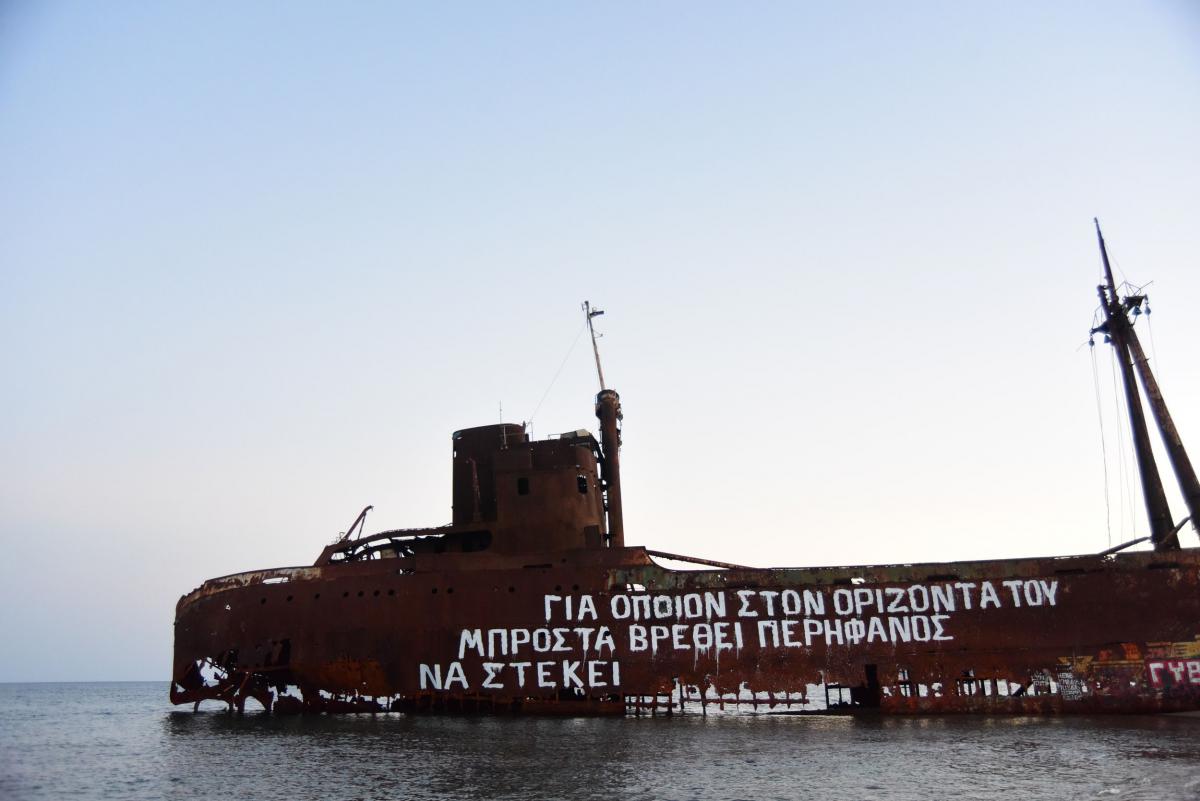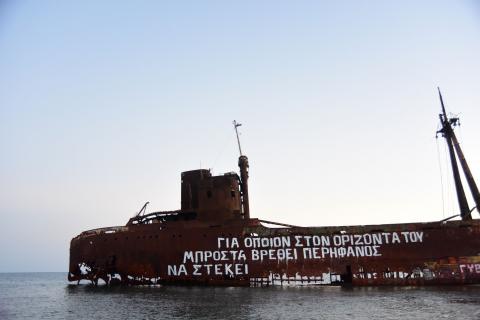Dimitrios shipwreck, Gytheion 2006. Picture: Orestis Pangalos
Searching 'Dimitrios Shipwreck' on the web once can see that it is labeled as a tourist site. A great number of images of it have already been uploaded on the web. Additionally, if one googles ‘shipwreck’ many of its images will appear on the top results, or even appear first. Through such a process, we could safely state that Dimitrios in many respects has changed from being picturesque to becoming iconic.
The making of the music video Darkness is not black[1] led a team of friends to explore and revisit multiple locations around Greece in order to fit the writing of the song lyrics on site. The symbolisms, aesthetics and poetics of each place were important criteria for the choices, while in turn the displayed words should in some way correspond to the sites. In particular, the film locations were chosen for a sense of abandonment and desolation which lends them certain energy as well as an aura of mystery. A number of the sites were seen by the crew that was taking part on the expeditions as monumental; they consisted of landscapes, objects, structures and buildings that in some cases approached the status of monument. The question arose whether an abandoned site or object can denote a monument and what it is that makes it to be thought as such. Dimitrios shipwreck in Gytheion, South Peloponnese was by far the most impressive of relevant examples and its case will be further examined here.
Usually a monument is built in memory of a person, an event, or even as remembrance of a whole era or culture. In other cases, existing structures like old historical buildings, ancient sites are officially declared monuments, and thus have to be protected and preserved, conserved and even reconstructed. Consequently, it is very common that tourists would visit and make pictures of them. Dimitrios has been staying in the same location for nearly forty years, aging and rusting. It is impossible to miss it when driving the provincial nearby road from a distance of approximately 150 meters. Its size and placement compose quite a rare scenery which gets more and more stunning upon approaching it.
In the past many travelers would stop by while others would visit it in order to experience its view. Lately it has become even more popular due to the advent of multiple digital platforms and social media featuring its pictures. It could be said that in the beginning there were a few people who were specifically attracted to it, and gradually it became an attraction for a wider audience of admirers. Today, many of the visitors feel they have to capture its image either on its own or with themselves in the foreground. Doing so, they treat the ship as a monument.
But what would it commemorate, or at least be reminiscent of? Might it just trigger connotations and emotions? Even though the feelings of each person might differ when watching it there are some underlying signifiers that could be more or less common: pirate stories, sailor myths and legends, ship imagery from movies and old paintings, smugglers and exploring expeditions, ghosts, haunted places, sea storms and post-apocalyptic sceneries among many others. The feeling can be a bit uncanny due to its large scale and its corroded surfaces that somehow resemble a prehistoric giant animal skeleton, while the aging vessel and its abandonment might ignite emotions of melancholy and loneliness. Additionally, it actually stands like a contemporary ruin, like a decayed structure of a post-industrial era. The open sea, the shore, and the site as a whole contribute to its experience.[2] At the same time, it inspires awe and admiration, since it is a unique object; usually shipwrecks are sunk, or in similar cases they are destroyed, displaced and recycled. Its scale and uniqueness, the exceptional setting, the various stories behind it and all the fantasies it might awaken stand monumental, while its age and its visitors’ reactions make it look like a monument.
Dimitrios shipwreck, July 2006. Picture: Orestis Pangalos
What is exceptional about Dimitrios’ monumentality is that the wreck happened due to neglection and abandonment. Whether no one really cared enough to remove it all these years or for economic or bureaucratic reasons, the fact that it was left there to stand is what offered it its present state and made it what it is. Add the time and weather aging process and then this is very close to what could be described as a large-scale accidental monument.[3] On the other hand, in order to officially declare something as a monument an established proclamation by some official authority is needed in the first place.
We are not making an official proclamation; that might be quite interesting, but it would be quite complex and would have to involve many factors. It would also spark a huge discussion while so many other crucial cases involving monuments are open at the same time, plus it definitely needs some funding and protection.[4] Furthermore it would make sense if we considered that there are plenty of cases where vehicles became elements of artworks and monumental installations or monuments themselves; a ship bow at the Old Oil Mils Cultural Center of Elefsina, a military airplane at Kariotissa Pellas, the Hope for Peace Monument in Yarze, Lebanon, or the Cadillac Ranch in Amarillo, Texas. It is true that their symbolisms vary as well as their qualities and their audiences, but they definitely have something in common with Dimitrios. Except that Dimitrios was originally abandoned at that specific site which in fact grants it its added authenticity. It was actually the process of no decision taken that let it be and obtain its current look and status. Moreover, it was made by no artist even though it might be regarded as an exceptional work of art in public space; the only artists there are the photographers and the ones who write and draw on its surfaces.[5] Yet, while there is no artist or architect behind it[6] and since it has been an inseparable element of its landscape for the last forty years in a somewhat extreme metaphor the ship and its surrounding area are also close to what have been officially called Natural Monuments.[7]
But then again you never know; one would rightfully notice that modern history monuments and even older classical monuments from ancient times were not officially declared monuments until they were finally stated as such. To continue the hypothesis, even if Dimitrios were declared an official monument -of some yet unclassified kind, its preservation and conservation would demand a special and sensitive approach. However funny this cogitation might seem, pictures from a few years ago show that Dimitrios’ metal skeleton is now visible on both sides. Its iron surfaces have suffered extended corrosion and are gradually disappearing. In the most recent photographic images, it is evident that its sides are bending and it is a matter of time for big parts to collapse and most possibly Dimitrios will break into two or more pieces. It might look more beautiful in a sense, if we keep in mind that it has been undergoing organic transformation for the last four decades. If we see it as an accidental monument, also suffering physical damage, it would be fair for it to be left alone. However, in such a progression it would lose much of its monumental shape as well as much of its height and volume. Consequently, an iconic object and site would no longer exist, at least in the way it has been experienced by its visitors and captured in their pictures for so many years.
If we put aside for a while those hypothetic and largely subjective matters of monumentalization, matters of safety would be a good reason to invest in supporting its structure. Another charming element of Dimitrios is the relatively easy access to its sides and its interior too: thus, it serves as a playground for exploration and interaction also offering the pleasure of adventure. The possibilities of somebody getting hurt by a collapsing part are rather small, they are comparable to the dangers of, say, mountain trekking. On the beach there is an official sign which informs the visitors that “approaching the wreck is forbidden” and that they are in “danger of severe injuries”. Ironically, this awareness was not enough for any authorities to remove Dimitrios, in the same line with the practices of neglect that unintentionally resulted in this exceptional attraction. Many of its countless visitors, both the ones who seek and appreciate such kind of beauty, and the ones who were in some sense captivated without prior exposure to similar encounters would feel great disappointment and loss if the beach one day is found without its landmark.

Dimitrios shipwreck, September 2018. Picture: Orestis Pangalos
[1]Music video for rapper λ.ο.σ. (pronounced as l.o.s.), https://www.youtube.com/watch?v=QaWzraChTSc
[2]In many of the uploaded pictures on the Web one can observe how the weather and light each time combined with the shipwreck add to the atmosphere creating either idyllic either dramatic scenes.
[3]There is much discussion lately about accidental and unintentional art though it concerns mostly abstract forms. For more approaches in the subject see Pangalos, Orestis, 2019. “Two museum visits in Lund, Sweden, and the streets between them: Accidental monuments between public and curated spaces” in Punctum, 5(2), pp.155-181. Online access at http://punctum.gr
[4]A recent example of vehicles officially declared as ‘modern history monuments’ are the old Olympic Airways airplanes that have remained parked at the former Hellenikon airport in Athens since it was shut. The decision triggered much public discourse in the Media. Of course, there are innumerable cases of vehicles that are displayed in specialized museums that preserve vehicle collections of historical models. In the case of the German Technology Museum in Berlin an airplane is attached on the building, while building of the Amsterdam Maritime Museum resembles itself a ship.
[5] Let’s not forget that many monuments and sites of significance have been historically tagged (written) by people who belonged to any social group. Examples range from caves to mountaintops and from the Eiffel Tower to the Pyramids just to name a few.
[6] Only a designer but this is not the case here; it is not about the model of the ship but of its placement on space, its site-specificity as a landmark magically corresponding with its environment creating a scenery and an iconic image.
[7] In Greece such examples include trees, forests, rock formations or caves. The Monument Valley in the US is a typical example that includes the word itself. According to Wikipedia a natural monument is “a natural or natural/cultural feature of outstanding or unique value because of its inherent rarity, representative of aesthetic qualities or cultural significance”.


